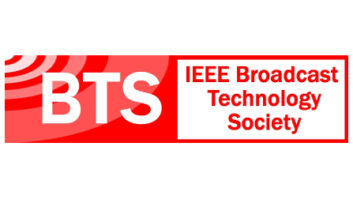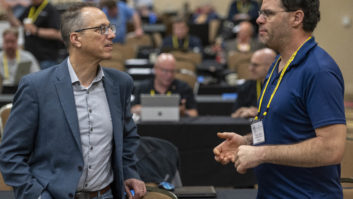The Broadcast Engineering Conference�s Radio Technology Forum features technical papers addressing the latest opportunities and challenges facing broadcast engineering professionals around the world. The track�s moderator is Milford Smith, vice president of radio engineering for Greater Media.
Here are descriptions from the presenters, as published by NAB, of a sampling of sessions that may be of particular interest to Radio readers.
NAB CTO Sam Matheny delivers the 2015 BEC keynote. He will speak again April 17 at 9 a.m.DIGITIZING TERRESTRIAL RADIO
SAT. APRIL 16 |3:25�� 3:55 P.M.|S219

This session will show that only when the end goal of pure digital transmission is reached can we achieve lowest transmission costs and best spectral efficiency. It will paint a vision of a true multimedia radio experience that is only achievable once we embrace all digital terrestrial radio broadcasting.
Presenter: Philipp Schmid, research engineer, Nautel Limited�
AUDIO PROCESSING CONFIGURATION AND ITS IMPACT ON HD RADIO BLENDING
APRIL 17|10 �10:30 A.M.|S227
This paper will review the HD Radio broadcast system form the viewpoint of audio alignment. It will explore the various points in the chain which can cause misalignment: audio processing differences, audio distribution paths, network reliability and STL feeds. We will also explore operational requirements to improve audio alignment and thereby improve the user experience. Finally, we will offer suggestions for real-time monitoring and correction of misalignment at the station.
Presenter: Jeff Detweiler, executive director, HD Radio, a DTS Solution
DISTRIBUTION OF ANALOG OR DIGITAL FM COMPOSITE MULTIPLEX SIGNALS ACROSS IP NETWORKS
APRIL 17|11:30 A.M. �12 P.M.|S227
We will look at various FM processing architecture chains where we have an audio processor, a RDS encoder, and a stereo generator which generates the final FM MPX signal and examine where these various elements can be located and where telecom networks are needed for signal transport. The quality of transport of a wideband analog and digital FM MPX signal over an IP network with typical network impairments presents challenges with regards to delay and data integrity. Various strategies can be deployed which can mitigate the effect of these network impairments. We examine these strategies, including differences in transport requirements between analog and digital FM MPX signals and the trade-offs they present with respect to bandwidth, scalability and delay.
Co-Presenters: Keyur Parikh, solutions architect, GatesAir; Junius Kim,
engineering project manager, GatesAir�
HD RADIO DIVERSITY DELAY FIELD OBSERVATIONS: THE NEED FOR AUTOMATIC ALIGNMENT
SUN. APRIL 17|1:30 � 2 P.M.|S227
Audible blending artifacts are the top HD Radio complaint from auto manufacturers and consumers. This paper will cover some of the causes of drift and how those can be resolved. However, we have learned there are a myriad of potential problems that can cause drift that are out of control of any individual device that has been traditionally installed in the broadcast chain. What is needed is a systems approach to this problem. This paper will discuss implementing various combinations of hardware and/or software to provide continuous monitoring and adjustment of diversity delay in real-time to reduce or eliminate the objectionable blending artifacts impacting listeners.
Presenter: Alan Jurison, senior operations engineer, iHeartMedia�
NAB LABS ALL-DIGITAL AM TEST PROJECT – PART II, CO-CHANNEL LABORATORY TEST RESULTS
APRIL 17|2 � 2:30 P.M.|S227
Since 2012, NAB Labs has been conducting field and laboratory tests of the HD Radio all-digital AM system. The purpose of this test project has been to characterize the digital coverage performance and interference behavior of the all-digital AM signal under a variety of conditions, with the goals of better understanding the capabilities and limitations of this signal and to develop a technical record of this as-yet unauthorized service. This paper provides a brief description of the all-digital AM signal, then offers a summary of the co-channel laboratory test results obtained by NAB Labs.
Co-Presenters: Mike Rhodes, senior engineer, Cavell, Mertz and Associates, Inc; Dan Ryson, senior engineer, Cavell, Mertz and Associates, Inc; David Layer, senior director, Advanced Engineering, National Association of Broadcasters
VIRTUAL FUTURE OF BROADCAST AUTOMATION
APRIL 17|4 � 4:30 P.M.|S227
As stations look for new ways to protect their data and simplify their audio routing, virtualization has grown in popularity. Virtualization of your broadcast automation and audio routing means less downtime for upgrades and maintenance, more secure storage of data, and redundant storage of your stations valuable data and configuration files. This seminar will discuss the advantages of virtualization and present a short case study of one or more stations/media groups using virtualized server. An emphasis will be placed on audio routing and how a virtual environment can help to protect a station in a time of equipment failure.
Presenter: Paul Stewart, technical support / R&D engineer, ENCO Systems, Inc.
WHEN NOT TO USE A MOMENT METHOD AM PROOF OF PERFORMANCE
APRIL 17|4:30 � 5 P.M.|S227
The adoption of the moment method proof of performance rules in MM Docket 93-177 was a monumental step forward into modern electromagnetic systems analysis for AM antenna performance. The process of this took an inordinate amount of time, but the result was a practical and scientifically valid set of procedures for avoiding the uncertainties and hazards of measuring magnetic field strengths in circumstances fraught with perils. But there are circumstances where this method shouldn�t be used.
Presenter: Benjamin Dawson, president, Hatfield & Dawson Consulting Engineers, LLC
ARCHITECTING A STATELESS, VIRTUALIZED, ZERO FIXED COST BROADCAST FACILITY
APRIL 18|11:30 A.M.�12 P.M.|S227
In this paper, we will explore the necessary hardware and software configurations, cloud-based models, and on-demand coordination of necessary resources. This paper will highlight the usage of Flexible Media Clusters, Software Defined Networking and Network Function Virtualization, OpenStack, Packet Media Networking solutions to replace SDI, software defined storage and resource reservation layers to elastically and dynamically provide a highly scalable all-IP based broadcasting architecture.
Presenter: Tom Ohanian, development and media segment strategist, Cisco Systems
The following are some additonal sessions within the Broadcast Engineering Conference that will be of interest to radio and multiplatform tech managers. For the full schedule, go tonabshow.com.
Broadcast Engineering Conference Keynote
April 17, 9�9:30 a.m.
LVCC S219
A Federated System for Public Media Metadata Delivery
April 17, 9:30�10 a.m.
LVCC S227
Digital MPX AES 192 in the Real World
April 17, 11�11:30 a.m.
LVCC S227
Emulation, Expectations and Why Things Sound The Way They Do
April 17, 1�1:30 p.m.,
LVCC S227
Real-Life AM Revitalization
April 17, 2:30�3 p.m.
LVCC S227
The AES Loudness Guidelines for Internet Audio and What they Mean for Producers, Distributors and Listeners
April 17, 3�3:30 p.m.
LVCC S227
The Elusive Signature Sound
April 17, 3:30�4 p.m.
LVCC S227
Extending IP Audio to the Transmitter Using Part 101 or Unlicensed IP Radios
April 19, 10:30�11 a.m.
Emergency Preparedness
April 20, 9 a.m.�Noon,
LVCC S228
Continuity of Broadcast Operations During Disasters
April 20, 9:30�10 a.m.
Cyber-Security and Network Integrity for HD Radio Broadcasting
April 20, 2:30�3 p.m.
AM Bootcamp
April 20, 2:15�3 p.m.
FM Bootcamp
April 20, 3�3:45 p.m.
Amateur Radio Operators Reception
April 20, 6�8 p.m.,
Westgate Ballroom B
Data Networks and the Broadcast Plant
April 21, 9 a.m.�Noon,
LVCC S225
Troubleshooting the Broadcast IP Network
April 21, 11:30 a.m.�Noon












